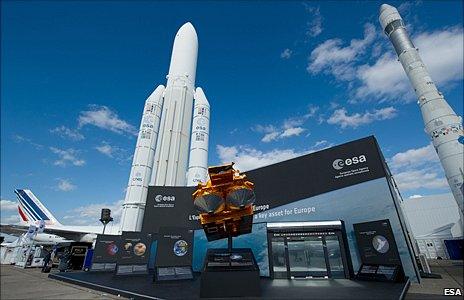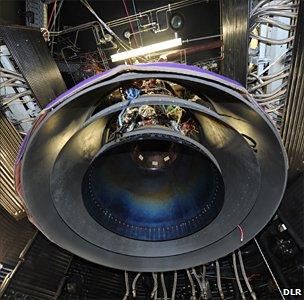Ariane rocket aims to pick up the pace
- Published
- comments

It is now 44 successful missions on the trot
There's a stage as you move towards middle-age when you think you might be getting on top of things - that you can handle most of anything that's chucked at you.
Then you look at what the youngsters are doing and you suddenly realise you'd better up your game or you could be overrun.
So it is with Europe's Ariane 5 rocket, external. After a troublesome youth, the vehicle has matured into an ultra-reliable performer.
Its consistency - 44 successful missions on the bounce - means it is now the number one choice to launch a big commercial telecommunications satellite.
A half of all these spacecraft that go into orbit each year will ride Europe's "battle-horse" launcher.
And yet, even as Ariane sits on top of the pack, there's a recognition it needs to move forward.
The market in which it functions is currently enjoying strong orders, a consequence of the fact that many satellite owners are in the process of upgrading their fleets.
Arianespace, external, the company that operates Ariane, has benefited from this buoyancy and currently has a backlog of satellites waiting to launch that is worth some four billion euros (£3.5bn).
However, Arianespace still cannot make a profit; and this year, European governments, who are the ultimate owners and chief stakeholders in the Ariane project, had to pump 120 million euros into the firm.
They will do the same again next year as everyone considers how best to shape the business for a more sustainable future.
The key imperative right now is to reduce the cost, and therefore the price, of launching the rocket - something up to about 150 million euros per flight.
One way to do that is to increase the rocket's performance.
Ariane carries up two satellites on the same flight - one big spacecraft with one smaller platform.
But matching the most appropriate pair is not always straightforward, and Ariane sometimes flies with a dual payload that is not maximising the price per kilo carried.

A huge model of the Ariane 5 dominates the Paris Air Show
In recent years, engineers have continued to eke out additional mass margin on the rocket. What was once a 9.4-tonne total payload limit will very shortly become 10.5 tonnes.
And currently in development is a new engine for Ariane's upper-stage. This Vinci unit will not only deliver more performance, enabling Ariane to loft up to 12.5 tonnes into geostationary transfer orbit (GTO), but this engine will be re-ignitable as well.
Stopping and re-starting a rocket in the vacuum of space is not a straightforward process but having such a capability makes it possible to put satellites into a broader range of orbits.
All the above gives Ariane the greatest flexibility to mix and match payloads, making it even more attractive to customers.
At the same time, Arianespace would find efficiencies in operating a single model of rocket to carry out every type of mission. Today, it is running two variants of the Ariane 5.
Ultimately, though, there's only so much you can do to fine-tune a 20-year-old design, and one that was originally envisaged - let's not forget - to launch astronauts, with all the extra assurance and cost that human spaceflight entails.
So, at some point, Europe will have to go for a fresh start, which is why discussions have already begun around the prospects for a successor - an Ariane 6.
The feasibility studies on this new rocket are being led by Astrium Space Transportation, which is also the prime contractor on the current vehicle.
Engineers are considering several different concepts for this Next Generation Launcher (NGL), external.
Present thinking seems to be that it will abandon the dual-payload approach in favour of a design that is modular enough that it can loft a single satellite that weighs anything from three tonnes all the way up to six, and possibly even eight, tonnes.
At the Paris Air Show this week, I spent some time talking with Alain Charmeau, the CEO of Astrium Space Transportation, external.
He laid out the challenge for the next generation of launcher.
"NGL is not so much about improving performance; we have the needed performance. NGL is about improvements for lowering the cost," he told me.
"With NGL, we are talking about reducing the cost by 40%, with a single payload, when compared to Ariane today.
"We need efficiencies everywhere. We have to work on everything - on propulsion, on structures, on avionics, on cabling. For example, am I able to use the carbon fibres that are used by Airbus in order to have cheaper materials than the space-dedicated carbon fibres I use today?
"Our friends at Safran, external are working to simplify the cryogenic engines, to halve the number of pieces in an engine - because we know the cost is more or less a function of the number of sub-assemblies or pieces you have in that engine. All of this would help to reduce the cost."

Vinci will bring more performance and greater flexibility in the missions that can be flown
No-one really expects the launcher market to get easier - quite the opposite. The cycle of renewal that satellite operators are in will inevitably turn down, reducing the number of contracts offered to rocket companies.
At the same time, the choice of rocket on offer to these operators is set to expand. The Sea Launch company, which fires its rockets from a converted oil rig in the Pacific, is about to re-enter the fray after several years on the sidelines reorganising its finances.
But perhaps even more disruptive could be the emergence of the California SpaceX company and its Falcon 9 rocket. This vehicle is being offered to the market at prices that substantially undercut those of all the other rocket companies.
We'll see how real those prices are; many commentators expect them to rise.
In any case, Arianespace has to stay as nimble as possible. In October, it should start launching Russian Soyuz rockets from its French Guiana spaceport in addition to Ariane. And then, at the end of the year, it expects to introduce the Vega vehicle, a small rocket, external designed to carry scientific payloads into orbit.
A busy spaceport is an efficient one, says Jean-Yves Le Gall, the CEO of Arianespace.
"We plan to have an average of six to seven Ariane 5 launches, plus two to four Soyuz and one or two Vega," he told me.
"I committed in front of European member states and my shareholders to drastically reduce the operating costs in French Guiana, and we are going to decrease these costs by 20%. This is, in particular, the result of the synergies that are going to be established between Ariane 5, Soyuz and Vega. It is a dividend from the joint operations.
"Member states dreamt about this cost reduction and Arianespace will deliver it."